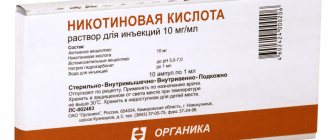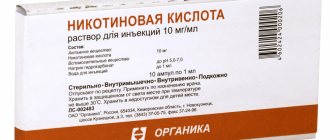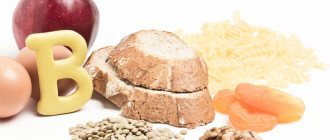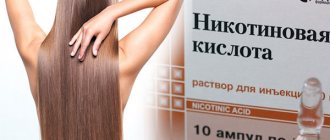Nicotinic acid is a vital vitamin, the supply of which is absolutely necessary for all people, including healthy ones. The drug is available in the form of injections and tablets. It is used for the prevention and treatment of atherosclerosis, cerebrovascular accidents, colitis, gastritis with low acidity and other dangerous pathologies.
Pharmacodynamics and pharmacokinetics
Vitamin PP (nicotinic acid) is a vitamin that takes part in a large number of oxidative reactions occurring in living cells.
The drug has a specific anti-pellagric effect and is used to improve the activity of blood vessels .
The administration of nicotinic acid preparations makes it possible to normalize the permeability of vascular walls and, accordingly, reduce tissue swelling, improve the state of tissue (in particular, nitrogen and carbohydrate) metabolism and microcirculation, expand the lumen of blood vessels (a vasodilating effect is noted at the level of small blood vessels, including the vessels of the brain brain), increase the fibrinolytic activity of blood plasma and reduce platelet aggregation by suppressing the synthesis of TxAj (thromboxane A2), a mediator of their aggregation and degranulation.
In the body, vitamin PP is biotransformed into nicotinamide , which binds to the hydrogen-transferring coenzymes NAD and NADP. Regulates oxidation-reduction reactions, takes part in synthetic processes, metabolism of amino acids , fats , purines , proteins , as well as in glycogenesis and tissue respiration .
Reduces the rate of VLDL synthesis and inhibits lipolysis (fat degradation) in adipose tissue. Helps normalize blood lipid composition: reduces the concentration of LDL, triglycerides and total cholesterol , while increasing the content of HDL in the blood. Shows antiatherogenic and detoxification properties .
Ensures the conversion of the trans-form of retinol into cis-retinal, which is used in the synthesis of the visual pigment rhodopsin, stimulates the release of histamine and promotes the activation of kininogenesis.
Vitamin B3 is well absorbed in the pylorus of the stomach and the upper parts of the duodenum . With the participation of pyridoxine and riboflavin, it can be produced by the bacterial flora of the intestine from tryptophan , which comes with food. tryptophan required to form a milligram of the substance is 60 mg.
Metabolization occurs in the liver. Nicotinic acid and its metabolic products are excreted by the kidneys; when taken in high doses, the substance is excreted primarily in pure form.
Composition and other characteristics
Nicotinic acid (also vitamin PP or vitamin B3) is available in the form of tablets (50 mg of active ingredient each) and injections for injections (aqueous solution of 0.1% concentration). Tablets are produced in packs of 10 or 50 pieces, injections - in glass ampoules.
Vitamin B3 promotes vasodilation, lowering cholesterol and lipid levels. It is an essential, vital substance that is involved in many metabolic processes and is involved in maintaining homeostasis (constancy of the internal environment).
The drug is sold in pharmacies and is dispensed only with a prescription. Can be stored under normal conditions (room temperature, moderate humidity, away from sunlight). The shelf life is 5 years for solution and 4 years for tablets.
Indications for use
Indications for the use of Nicotinic acid are:
- hypo- and avitaminosis caused by insufficient intake of vitamin B3 from food, exclusively parenteral nutrition, malabsorption syndrome (including against the background of pancreatic ), Hartnup disease, rapid weight loss, gastrectomy , diseases of the digestive system ( persistent diarrhea , including tropical , celiac enteropathy , Crohn's disease );
- conditions accompanied by an increased need for vitamin PP (diseases of the hepatobiliary system, prolonged fever, hyperthyroidism , prolonged stress, chronic infections, pregnancy, lactation, cancer);
- hyperlipidemia (including triglyceridemia and hypercholesterolemia );
- atherosclerosis;
- obliterating diseases of the vessels of the lower extremities (for example, Raynaud's disease );
- ischemic cerebral circulatory disorders;
- spasm of the urinary and biliary tract, vessels of the extremities;
- microangiopathy;
- diabetic polyneuropathy;
- hypoacid gastritis;
- colitis and enterocolitis ;
- facial nerve neuropathy;
- trophic ulcers and non-healing wounds.
Contraindications
Categorical contraindications for both dosage forms of the drug are serious liver dysfunction, bleeding, cerebral hemorrhage, hypersensitivity to nicotinic acid.
Nicotinic acid tablets should also not be taken during periods of exacerbation of peptic ulcer disease and in children under 2 years of age (as an anti-sclerotic agent ).
Additional contraindications to the administration of Nicotinic acid in ampoules are: atherosclerosis , hyperuricemia , severe arterial hypertension , gout , childhood.
Use of niacin in medicine
Due to the peculiarities of its chemical structure, niacin (chemical formula C6H5NO2) is actively used in traditional medicine. Vitamin PP penetrates deeply into the cells of the body, so the range of its use is extremely wide.
Indications for the use of nicotinic acid:
- spinal hernia;
- brain dysfunction (memory impairment, inattention, absent-mindedness);
- depression;
- angina;
- acquired diabetes mellitus;
- alopecia;
- osteoarthritis;
- cardiovascular diseases;
- period;
- multiple sclerosis;
- vitamin deficiency (lack of vitamin B3/PP leads to decreased immunity);
- osteochondrosis, including cervical;
- pellagra – a disease that occurs due to a deficiency of vitamin PP in the human body due to poor nutrition; manifests itself in people suffering from alcoholism and chronic gastrointestinal diseases, but it is also often found in pregnant women;
- dysfunction of the small intestine;
- pathological abnormalities in the functioning of the liver, gall bladder, thyroid gland;
- gastritis;
- dysbacteriosis;
- anorexia;
- malignant tumors;
- headache.
Nicotinic acid will not be superfluous for people who drink alcohol or oral contraceptives; for smokers it is completely irreplaceable. For children, vitamin B3/PP is prescribed exclusively by a pediatrician if there is an urgent need.
Niacin helps fight secondary symptoms of diseases. The drug is used for numbness of the fingers caused by dorsopathies. Used in conjunction with B vitamins.
For prevention, vitamin PP should be taken in tablets; in the treatment of diseases, it is better to use the liquid form of the drug. Treatment regimens and dosages are prescribed after examination and collection of the patient’s medical history.
Side effects
The drug stimulates the release of histamine , which in some cases may be accompanied by:
- redness of the skin (mainly the upper half of the body and face) with a burning and tingling sensation;
- hypotension;
- orthostatic hypotension (with rapid injection into a vein);
- increased secretion of gastric juice;
- dyspepsia;
- dizziness;
- feeling of a rush of blood to the head;
- hives;
- itching.
Side effects associated with long-term use of high doses of vitamin B3 are expressed as:
- anorexia;
- impaired liver function and obesity;
- vomiting;
- diarrhea;
- irritation of the mucous membrane of the digestive canal;
- ulceration (ulceration) of the gastric mucosa;
- transient increase in the activity of alkaline phosphatase, aspartate aminotransferase, lactate dehydrogenase;
- paresthesia;
- arrhythmias;
- decreased glucose tolerance;
- hyperglycemia.
Instructions for use of Nicotinic acid
Nicotinic acid injections: instructions for use
The route of administration and dose depend on the indications. For ischemic stroke and pellagra, the solution is recommended to be injected slowly into a vein. For pellagra, it is also possible to give injections intramuscularly or subcutaneously.
Antipellagric therapy involves a single or double dose of 50 mg intravenously or 100 mg intramuscularly. The duration of treatment is 10-15 days.
For ischemic stroke, the drug is administered in a dose varying from 10 to 50 mg.
Injections can be given in three ways:
- 1 ml of a one percent solution into the muscle;
- intradermally (to replenish the need for vitamin);
- into a vein, 1-5 ml of a one percent solution, previously diluted in 5 ml of physiological solution.
IM and subcutaneous injections of the drug are quite painful and may be accompanied by a burning sensation. Intravenous injection may cause skin redness and a feeling of heat.
Such a reaction of the body is normal. On the contrary, the absence of redness may indicate the presence of certain problems with blood circulation.
Instructions for tablets
The tablets are taken after meals.
The prophylactic dose for adults varies from 12.5 to 25 mg per day, for children - from 5 to 25 mg per day.
For pellagra, adult patients are prescribed to take 100 mg of nicotinic acid 2 to 4 times a day. Course duration is 2-3 weeks. Children are given the drug 12.5-50 mg two or three times a day.
For vascular lesions of atherosclerotic origin, patients are recommended to take 2 to 3 grams of vitamin PP .
The starting dose for dyslipidemia is 50 mg per day in one dose. Subsequently, if the therapy does not provoke adverse reactions, the frequency of applications is increased to 2-3 times a day. The duration of the course is from one month. Intervals should be maintained between repeated courses.
In all other cases, the daily dose for adults is from 20 to 50, for children - from 12.5 to 25 mg. In some cases, the doctor may increase the daily dose to 100 mg for an adult patient. Depending on the indications, tablets are taken 2 or 3 times a day.
Signs of excess and deficiency of niacin in the body
To maintain normal vitamin B3 levels, it is recommended for an adult to consume 20 mg of the substance per day. For children, the volume is set at 6 mg depending on age. Boys of adolescence need an increased amount of nicotinic acid, unlike girls.
Women during pregnancy and lactation, and performing athletes consume vitamin PP in the amount of 25 mg per day.
Depending on nutrition and the use of nutritional supplements, the body may have either a deficiency or an overdose of the substance. The reaction to the drug vaguely resembles an allergy, so the benefits and harms of “nicotine” are regularly discussed on forums and chats.
Symptoms of excess vitamin B3/PP:
- deterioration of the digestive tract;
- lack of appetite;
- nausea;
- weakness;
- diarrhea;
- muscle pain;
- sleep disorders;
- hallucinations.
A lack of vitamin B3/PP is manifested by a deterioration in the body’s condition:
- skin problems (redness, rashes, peeling, dermatitis, etc.);
- tachycardia;
- low blood sugar;
- pain in the upper and lower extremities;
- weakness.
To replenish your supply of nicotinic acid, add foods with a high content of the substance to your usual diet. Despite culinary processing (frying, drying, canning), 90% of the vitamin remains intact. We'll tell you more about the group of foods with high levels of niacin below.
An overdose of vitamin PP does not pose a danger to human health. Testing has shown that negative symptoms such as dizziness, redness of the scalp, and numbness in most cases appear after taking the vitamin on an empty stomach.
For medicinal purposes, nicotinic acid is administered intravenously; in this case, blood pressure may drop sharply; to avoid a drop, it is better to administer the injection while sitting or lying down. After some time, the processes will normalize and the side effects will disappear.
You should not use nicotinic acid on your own, since it is a drug prescribed by a doctor.
With prolonged use of the drug, the following symptoms are possible:
- loss of appetite;
- constant pain in the head;
- change in urine color;
- yellowish skin color;
- liver dystrophy.
To avoid negative consequences, you should use the drug responsibly. In parallel with nicotinamide, it will be useful to take methionine and lipotropic agents. Products containing increased amounts of methionine:
- cottage cheese;
- meat;
- fish;
- eggs;
- cheese.
Nicotinic acid is a harmless vitamin when used within reasonable limits, but not everyone can use it. Contraindications for taking vitamin PP are clearly stated in the instructions: liver disease, stomach and duodenal ulcers, gout; with caution - hypertension and atherosclerotic vascular lesions.
This is not all that vitamin B3 is useful for.
Interaction
N. acid enhances the effect of vasoactive drugs (in particular, ganglion blockers), which may be accompanied by attacks of orthostatic hypotension .
Bile acid sequestrants (for example, colestipol or cholestyramine ) reduce the bioavailability of acidic drugs, including n. acid, so the drug should be taken at least one hour before or no earlier than four hours after taking these medications.
When conducting an analysis to determine the level of glucose in urine, the drug may provoke a false-positive reaction with Benedict's reagent (copper sulfate solution).
N. acid has hyperglycemic potential and can significantly reduce the activity of acarbose, which can cause the development of decompensation of diabetes mellitus .
Due to the ability of N. acids cause hyperglycemia , patients who are prescribed the drug in combination with “ metformin + saxagliptin ” or “metformin + sitagliptin ” should constantly monitor their glycemic control parameters.
In patients taking nadroparin calcium, it is necessary to keep hemocoagulation parameters under control.
With simultaneous use of n. acids and combinations “ amlodipine + atorvastatin ”, n. acid and simvastatin , n. acid and lovastatin may increase the risk of developing myopathy . Combination n. acid with simvastatin can also provoke rhabdomyolysis .
Myopathy and rhabdomyolysis are also possible when using the combination “n. acid in lipid-lowering doses and Simvastatin + Ezetimibe .”
The risk of developing myopathy also increases when lipid-lowering (exceeding 1 gram per day) doses of n. acids in combination with Rosuvastatin . In this regard, treatment with Rosuvastatin should be started at 5 mg/day.
The combination “Nicotinic + Ascorbic acid ” should be used with caution.
The possibility of drug interaction with sodium heparin .
High doses n. acids reduce the effectiveness of the combination “ Glibenclamide + Metformin ”, the hypoglycemic effect of Gliclazide and the effectiveness of the combination “ Gliclazide + Metformin ”, as well as the hypoglycemic effect of Glimepiride .
When used simultaneously with n. acid reduces the effect:
- Glipizide;
- hypoglycemic effect of Gliquidone ;
- Insulin Lispro (including biphasic);
- Metformin;
- Repaglinide;
- hypnotic effect of Phenobarbital .
It is forbidden to mix n in one syringe. acid and Thiamine .
Despite the fact that the simultaneous use of n. acids with HMG-CoA reductase inhibitors can provoke myopathy , with simultaneous administration of the drug with Fluvastatin , the bioavailability of the latter, as well as the bioavailability of n. acid does not change. However, this combination should be used with caution.
The harm of nicotine
Nicotine is a very harmful substance.
Nicotine is a dangerous neurotoxin. When poisoned, it causes cardiac arrest and paralysis of the nervous system.
The average lethal dose for humans is in the range of 0.5–1 mg per 1 kg of body weight. That is, for a man weighing 75 kg, 35 to 75 mg of this alkaloid is enough. So, indeed, a drop of pure nicotine will kill not only a horse, but also an elephant.
When smoking leaves of nicotine-containing plants, physical dependence develops. Constant contact with an alkaloid provokes pathologies of the heart and blood vessels, oncopathologies of the respiratory system and oral cavity, inflammatory processes in the gums, and stomatitis.
special instructions
What is vitamin PP?
Wikipedia answers the question “what is nicotinic acid” that it is a white powdery substance, odorless and slightly sour in taste. The powder dissolves poorly in cold water, ethanol, ether and slightly better in hot water.
The gross formula of the substance is C₆H₅NO₂. It was first obtained in 1867 by the oxidation of nicotine with H2CrO4 (chromic acid).
The benefits and harms of vitamin B3
Pure vitamin B3 can strengthen the immune system so much that the human body acquires natural protection against Staphylococcus aureus and a number of other, no less serious, viruses.
Scientists are confident that very high doses can even stop HIV infection and bacterial infections, against which most existing drugs are powerless.
In addition, vitamin B3 has detoxifying .
The body of an adult man requires from 16 to 28 mg of vitamin B3 , the body of a woman - from 14 to 20 mg.
The need for the vitamin will increase during intense nervous and mental activity, increased physical activity, in people working in a hot shop, in a hot climate and in the Far North, during pregnancy and during breastfeeding, in people whose diets include vegetable proteins over animals (including people fasting and people on a low-protein diet).
Nicotinic acid is necessary for the release of energy from fats and carbohydrates, as well as for the normal course of protein metabolism. It normalizes the functioning of the pancreas and stomach, and is also part of the enzymes that ensure cellular respiration.
The vitamin has a beneficial effect on the heart, blood vessels, nervous system, maintains healthy mucous membranes of the oral cavity and intestines, and skin; takes part in ensuring normal vision, reduces high blood pressure and improves blood circulation.
Some scientists are inclined to believe that vitamin B3 prevents the cancerous degeneration of cells.
A lack of this substance in the body is accompanied by apathy, lethargy, fatigue, headaches, dizziness, dry and pale skin, insomnia, irritability, decreased appetite and body weight, constipation, palpitations, and decreased resistance to infections.
If a person does not receive enough nicotinic acid, he develops the disease pellagra . The first signs of the disease are:
- frequent, watery stools (3 or more times a day, without blood or mucus);
- poor appetite, heaviness in the stomach;
- belching and heartburn;
- redness of the oral mucosa;
- salivation , burning in the mouth;
- swelling and cracking of lips;
- protrusion of the papillae of the tongue with red dots;
- the appearance of deep cracks in the tongue and red spots on the face, hands, elbows and neck;
- swelling of the skin (which may hurt, itch, or form blisters);
- noise in ears;
- severe weakness;
- headache;
- crawling sensation and numbness;
- pressure fluctuations;
- unsteady gait.
Excess vitamin in turn can cause skin rashes, itching and fainting.
Products containing vitamin B3
To prevent hypovitaminosis PP , it is preferable to adjust the diet so that vitamin B3- containing foods are present in the diet.
Where is niacin found? In foods, the greatest amount of vitamin B3 can be found in liver, egg yolk, yeast, nuts, fish, milk, chicken, green vegetables, meat, legumes, ground nuts, buckwheat and any other food containing the α-amino acid tryptophan .
Heat treatment does not affect the amount of vitamin.
Why is Nicotinic acid needed in cosmetology?
Despite the fact that the instructions do not contain recommendations regarding the use of Nicotinic acid for hair growth or facial skin, this product is quite often used in beauty salons.
The rejuvenating effect of the drug is based on the ability of nicotinic acid to dilate blood vessels in the peripheral part of the circulatory system, increase the supply of oxygen to tissues, enhance the outflow and removal of aggressive waste and free radicals from skin cells.
As a result, the skin smoothes out, becomes more hydrated and acquires a beautiful and even color.
Nicotinic acid is also used for hair growth. One course usually requires at least 30 ampoules of solution.
After opening the ampoule, the solution is transferred with a syringe into a small container, after which it is distributed with your fingers (or a syringe without a needle) over the entire scalp: first at the temples and along the hairline, then along the partings. Typically, 1 ml of solution is sufficient for one procedure (this corresponds to the contents of 1 ampoule).
It is very important that your hair is clean, since a build-up of dust and grease will prevent the product from being absorbed into the scalp. Before using the drug, you should not use shampoos with silicones to wash your hair, as they will create a barrier for the drug to penetrate into the tissue.
Nicotinic acid is destroyed quite quickly in air, so the procedure should be performed as quickly as possible. An open ampoule cannot be stored.
Normal reactions to the drug are a slight burning sensation, a crawling sensation, redness and burning of the skin.
The appearance of hives, rashes, itching, and headaches indicate intolerance to nicotinic acid. If these symptoms occur, you should wash your hair and stop using the product further.
If, after using Nicotinic acid for hair, the scalp becomes dry or appears, it is recommended to dilute the solution with water in a 1:1 ratio. Such reactions are a consequence of skin sensitivity. Aloe juice can also be used as an alternative to water .
Once the solution is completely applied, the procedure is considered complete. Repeat it daily for a month. There is no need to wash off the drug.
After completing the course, almost all girls note hair growth of 3 cm.
An injection solution of Nicotinic acid has also found use as a remedy for cellulite. Before the procedure, the contents of one ampoule are diluted in 3 ml of water. Then a wide bandage is moistened in the resulting solution and tightly - but not tightly! - wrap it around problem areas.
This method is most effective in getting rid of cellulite on the thighs and abdomen, since these are the areas of the body that are most convenient to bandage. But to eliminate cellulite on the buttocks, it is recommended to use other means.
The bandages are wrapped in cling film and a towel (for insulation). Instead of a towel, you can use a blanket or blanket.
The duration of the first procedure should not exceed 15 minutes. If the skin responds well to the drug and there are no side effects, the time may be increased in the future.
Precautionary measures
It should be borne in mind that nicotinic acid injections are painful.
During treatment, it is necessary to constantly monitor liver function, especially if the patient is prescribed high doses of vitamin B3 .
To prevent hepatotoxicity, it is recommended to introduce a sufficient amount of methionine- foods into the patient’s diet (milk, dairy products, buckwheat, legumes, fish) or prescribe him to take lipotropic drugs (including methionine ).
Nicotinic acid, given its ability to irritate the mucous membrane, is used with caution for peptic ulcer disease (in remission) and hyperacid gastritis . If it is necessary to prescribe the drug in these cases, taking large doses is contraindicated.
To reduce the irritating effect on the mucous membrane of the digestive tract, it is recommended to take the tablets with milk.
Due to the likelihood of hepatotoxicity, taking high doses of vitamin B3 is also contraindicated for liver diseases (including hepatitis and cirrhosis ) and diabetes mellitus .
The use of the drug for the correction of dyslipidemia in diabetes mellitus is inappropriate.
Requirement of humans and animals for vitamin PP
We see that NAD is found in tissues in much larger quantities than NADP. Based on their content in tissues, one can judge the intensity of participation of these coenzymes in metabolism. In cells, the NAD/NAD-H2 ratio is higher than the NADP/NADP-H2 ratio. NAD and NADP in cells, based on the calculation of the enzymatic activity of the entire homogenate, are contained in greater quantities in the nucleus, where their synthesis occurs, and in smaller quantities in mitochondria and microsomes. The enzyme NAD-pyrophosphorylase is part of the enzymes of the cell nucleus, NAD-H -cytochrome C-reductase and NADP-H-cytochrome C-reductase - part of the enzymes of the nuclear membrane itself, NAD-H-dehydrogenase, NAD-H-cytochrome C-reductase, NAD-H-cytochrome B5-reductase, NAD-H- oxidase and NAD- and NADP-isocitrate dehydrogenase - in the composition of mitochondrial enzymes, NAD-H-cytochrome C-reductase, NAD-H2-oxidase, NADP-H2-cytochrome C-reductase - in the composition of enzymes of the endoplasmic reticulum. Thus, NAD and NADP participate as coenzymes in a number of very important enzyme metabolic systems in humans and animals. However, due to the structural features of the protein components of dehydrogenases, the connection of the coenzymes NAD and NADP with these enzymes is less strong than other vitamin-containing enzymes. As a result, NAD and NADP can take part in many oxidation and reduction reactions, migrating from one apoenzyme to another.
The nucleotides NAD and NADP, containing nicotinic acid amide as a catalytically active group, are among the most universal coenzymes in terms of distribution and biological role.
One of the most characteristic physical properties of nicotinamide coenzymes is the presence of reduced forms (NAD-H2 and NADP-H2) of an absorption band in ultraviolet light with a maximum at 340 nm. Excitation of NADP-H2 by radiation with this wavelength leads to the appearance of fluorescence with a maximum at 480 nm.
Spectrophotometric and spectrofluorimetric methods based on these properties are used for the analytical determination of nicotinamide coenzymes, as well as for measuring the activity of associated dehydrogenases.
With the participation of nicotinamide coenzymes, specific dehydrogenases catalyze the reversible reactions of dehydrogenation of alcohols, hydroxy acids and some amino acids into the corresponding aldehydes, ketones and keto acids. Currently, the properties of a large number of enzymes containing nicotinamide as a coenzyme have been isolated and studied.
The most important of these enzymes are:
1. Alcohol dehydrogenases (EC 1.1.1 -2).
R-CH2—OH+NAD (or NADP)—R-CHO + NAD-H (or NADP-H) + H+
2. Aldehyde dehydrogenases (EC 1.2.1.3-5)
R-CHO+H2O+NAD (or NADP)—-R-COOH+NAD-H (or NADP-H) + H+
3. Glucose dehydrogenase (EC 1.1.1.47).
D-glucose + NAD (or NADP) - delta-lactone-D-gluconic acid + NAD-H (or NADP-H) + H+
4. D-glucose-b-phosphate dehydrogenase (EC 1.1.1.49)
D-glucose-b-phosphate + NADP—-delta-lactone-6-phosphate of D-gluconic acid + NADP-H + H+
5. L-glutamic acid dehydrogenase (EC 1.4.1.2-4)
L-glutamic acid + NAD (or NADP) + H2O—— alpha-ketoglutaric acid + NH+ + NAD-H (or NADP-H)
6. L-glycero-3-phosphate dehydrogenase (EC 1.1.1.8)
L-glycero-3-phosphate + NAD - dioxyacetone phosphate + NAD-H + H+
7. Lactic and malic acid dehydrogenase (EC 1.1.1.27-28; 1.1.1.37-40)
R-CHOH—COOH + NADP—— R—CO—COOH + NADP-H + H+
The most important biological function of nicotinamide coenzymes is their participation in the transfer of electrons and hydrogen from oxidizing substrates to oxygen during cellular respiration. NAD and NADP molecules in oxidized form have pronounced acceptor properties, regardless of whether they are obtained by biosynthesis or chemically. It can be concluded that the mechanism of chemical action of these coenzymes is based on the high electron affinity of nicotinamide. Based on quantum mechanics, this is determined by its lowest free molecular orbit. In oxidized forms, NAD and NADP are strong electron acceptors. Since their highest filled orbit is low, they are weak electron donors. For the reduced forms of NAD and NADP, the orbital energies have an inverse relationship, so coenzymes in the oxidized form tend to capture electrons, and in the reduced form, to give them away. We see this in the example of a number of compounds in the formation of which NAD is involved.
Thus, the coenzyme functions of NAD and NADP manifest themselves mainly in redox reactions, in the reversible addition of a hydrogen atom. The main function of coenzymes is expressed in the reversible transformation of the pyridine ring into a 1,4-dihydropyridine ring.
When the pyridine ring is hydrogenated, its light absorption changes. The dihydropyridine system has an absorption maximum at 340 nm, while the pyridine system has almost no absorption in this region. In dehydrogenation processes that are catalyzed by nicotinamide coenzymes, the substrate donates two hydrogen atoms (2H or 2H+ + 2e), but only one H atom joins the coenzyme molecule (in the fourth position of the pyridine ring), and the second H atom gives an electron to the coenzyme and turns into H+ (proton). It has been established that the transfer of the H atom from the substrate to NADP occurs directly and stereospecifically for a given enzyme, always in one direction of the plane of the pyridine core of NADP. Depending on the direction of addition of the hydrogen atom, all dehydrogenases containing NAD are divided into two types - A and B.
Type A includes dehydrogenases of alcohols, L-lactate, L-malate, D-glycerate, acetaldehyde, etc., while type B includes dehydrogenases of L-glutamate, D-glucose, D-glycero-3-phosphate, D-glyceraldehyde -3-phosphate, beta-hydroxysteroids, etc. An example of the step-by-step inclusion of NAD, NAD-H2, NADP and NADP-H2 in the course of enzymatic reactions is the Krebs citric acid cycle. This cycle serves as the crossing point for all important metabolic reactions in which nicotinamide adenine dinucleotides take part.
In some enzymatic reactions, for example in the reaction of anaerobic breakdown of glucose, there are 2 enzymes - lactate dehydrogenase and phosphoglycerin aldehyde dehydrogenase, which are connected by the NAD-NAD-H2 system. This reaction is reversible and its direction is determined by the coefficient NAD/NAD -H2 and the concentration of substances in the reaction.
A special group of enzymes are transhydrogenases, which catalyze reactions between NAD and NADP-H2 towards the dehydrogenation of NADP-H2 at the expense of NAD.
With the help of a specific dehydrogenase, the coenzyme of which is NADP, folic acid is converted into tetrahydrofolic acid (see section “Folic acid”).
A special issue is the structure of the molecule NAD-H, which is a dihydropyridine, having two main types containing an alkyl group at position 1: 1-alkyl-1,2-dihydropyridines and 1-alkyl-1,4-dihydropyridines.
Dihydropyridines containing a urea group in the 3rd position are of greatest biological importance. These compounds have three isomers: 1,2, 1,4 and 1,6.
Nicotinic acid for weight loss
Nicotinic acid stimulates metabolic processes, and it is this property that makes it advisable to use the drug for weight loss.
The effect does not develop due to burning excess fat, but due to balancing the concentration of cholesterol in the blood and detoxifying the body.
To achieve more pronounced results, taking the tablets should be combined with reasonable physical activity, a balanced diet and drinking enough water. To speed up your metabolism as much as possible, it is best to take the tablets immediately after meals.
It should be remembered that people with high acidity of gastric juice are recommended to take the drug with warmed milk or mineral water.
Nicotine - what is it?
Most nicotine is found in tobacco.
Nicotine is a natural alkaloid. Contained mainly in green plants of the nightshade family.
The maximum concentrations of this substance are found in tobacco and shag. In the latter, the proportion of this alkaloid varies from 7 to 14%.
This substance is present in lower concentrations in tomatoes, peppers, and eggplants. Nicotine alkaloids are also found in coca leaves.
Nicotine is a powerful insecticide. And in the recent past, it was widely used to treat plants against pests. Currently, derivatives of this substance are used as insecticides.
Initially, tobacco was prescribed as a medicine for pathological headaches - migraines. Later, a mixture of natural alkaloids was obtained by sublimation. The organic extract was used in the treatment of asthma, inflammatory processes in the spleen, and to relieve epileptic seizures.
In appearance, nicotine in its pure form is an oily liquid. It is very hygroscopic and mixes with water in any proportions.
Reviews about Nicotinic acid
Reviews of Nicotinic acid tablets, as well as reviews of Nicotinic acid injections, are in most cases positive.
The drug has extensive indications for use and is effective for osteochondrosis of various parts of the spinal column, circulatory disorders in the brain and lower extremities, pellagra , decreased visual acuity, dyslipidemia , migraines , obesity, alcohol, occupational or drug intoxication, atherosclerosis and a number of other conditions.
Negative reviews are mainly due to the fact that after taking the tablets or administering the injection solution, the patient experienced a feeling of heat and severe redness of the skin. However, the instructions indicate that such phenomena are a normal physiological reaction of the body.
Reviews of Nicotinic acid for hair are also quite optimistic. The product helps strengthen the roots, improves blood circulation in the scalp, perfectly moisturizes the hair, eliminates dandruff, accelerates hair growth and prevents hair loss.
Cosmetologists recommend Nicotinic acid to improve complexion and skin condition, as well as to strengthen nails. In addition, Nicotinic acid is one of the most affordable and effective remedies for cellulite.
The metabolic effect of the drug allows it to be used to accelerate the breakdown of fats in programs aimed at reducing excess weight.
Despite the huge number of beneficial properties, nicotinic acid is a rather serious drug, the thoughtless use of which can lead to negative consequences for the body.
The advisability of prescribing a drug in one form or another can only be determined by a doctor.
Vitamin B3/PP during pregnancy
In gynecology, nicotinic acid is used to eliminate premenstrual syndrome, as a means of combating spasms and heavy bleeding. Vitamin B3/PP has a positive effect on the body, but there are still no studies clearly indicating whether women can take nicotinic acid during pregnancy.
The instructions for use of the drug state that the vitamin should not be used during pregnancy and lactation. But the substance is part of vitamin complexes for expectant mothers.
Nicotinic acid is prescribed to pregnant women and nursing mothers in the following cases:
- multiple pregnancy;
- pathological processes in the liver provoked by pregnancy;
- maternal dependence on nicotine and certain medications;
- abnormal functioning of the placenta.
Taking vitamin PP on your own during pregnancy without a doctor’s prescription is strictly prohibited. An overdose can adversely affect the development of the fetus. When breastfeeding, you can take the vitamin only if it is not contraindicated for the baby.
With controlled consumption of nicotinic acid, the expectant mother reduces spasms and improves blood circulation. When the fetus is oxygen starved, niacin improves the metabolic process and eliminates fetoplacental insufficiency. The antihypoxic agent in small doses ensures that the fetus receives the required amount of oxygen.
During pregnancy, nicotinic acid is prescribed to thin the blood to prevent blood clots. In this case, vitamin B3 acts as a prevention of premature birth and possible complications.
Nicotinic acid deficiency in the body of the expectant mother is manifested not only by hair loss and dry skin, but also negatively affects the psycho-emotional state of the woman. Scientific data on the change in mood of pregnant women from a cheerful laugher to a depressed virgin has confirmed that the cause of this phenomenon may be a lack of vitamin PP.
Nicotinic acid price, where to buy
The price of Nicotinic acid tablets in Russian pharmacies is from 12 rubles. You can buy ampoules for an average of 90-100 rubles per package No. 10.
In Ukraine, the price of Nicotinic acid in ampoules is from 25 UAH for 10 injections. Tablets will cost approximately 8-9 UAH.
Having found out how much Nicotinic acid costs, we can say with confidence that this is one of the most inexpensive products for hair, face and nails.
- Online pharmacies in RussiaRussia
- Online pharmacies in UkraineUkraine
- Online pharmacies in KazakhstanKazakhstan
ZdravCity
- Nicotinic acid for hair Mirrolla/Mirrolla 65ml Mirrolla Lab LLC
105 RUR order - Nicotinic acid solution for in. 1% 1ml 10 pcs. JSC Organika
56 RUR order
- Nicotinic acid tablets 50 mg 50 pcs. JSC Ufimsky Vitam.z-d
39 RUR order
- Nicotinic acid bufus solution for in. 1% 1ml 10 pcs. AO Renewal of PFC
120 rub. order
- Nicotinic acid solution for in. 1% 1ml 10 pcs. JSC Dalkhimfarm
50 rub. order
Pharmacy Dialogue
- Nicotinic acid (amp. 1% 1 ml No. 10) Organics (Novokuznetsk Autonomous Okrug)
59 RUR order
- Nicotinic acid (amp. 1% 1ml No. 10) DHF JSC
51 RUR order
- Nicotinic acid (for hair Mirrolla 65 ml)Mirrolla
113 RUR order
- Nicotinic acid (amp. 1% 1ml No. 10)Update of PFC JSC
114 RUR order
- Blagomin Vitamin PP (nicotinic acid) (caps. 250 mg No. 90) VIS LLC
RUB 309 order
show more
Pharmacy24
- Nicotinic acid 50 mg No. 50 tablets PrAT “Technolog”, Uman, Cherkasy region, Ukraine
11 UAH. order - Nicotinic acid-Darnitsa 1% 1 ml N10 solution for injection
34 UAH order
PaniPharmacy
- NICOTINIC ACID ampoule Nicotinic acid solution d/in. 1% amp. 1ml No. 10 Ukraine, Health LLC
34 UAH order
- NICOTINIC ACID ampoule Nicotinic acid solution d/in. 1% amp. 1ml No. 10 Ukraine, Darnitsa ChAO
35 UAH order
- NICOTINIC ACID tablets Nicotinic acid tablets. No. 50 Ukraine, Tekhnolog ChAO
11 UAH order
show more






